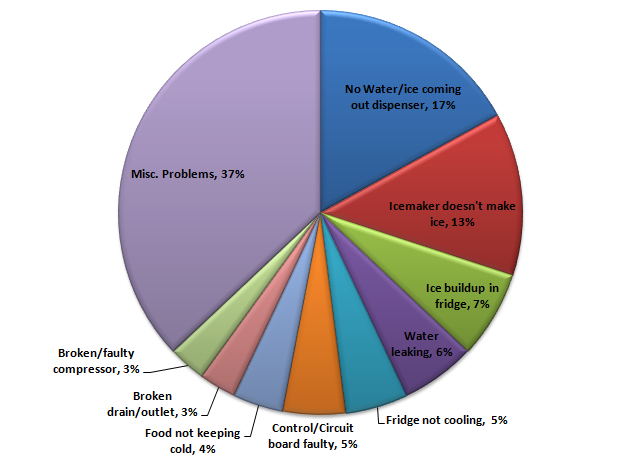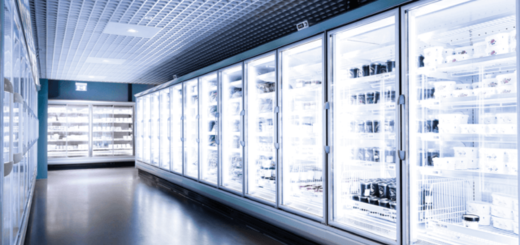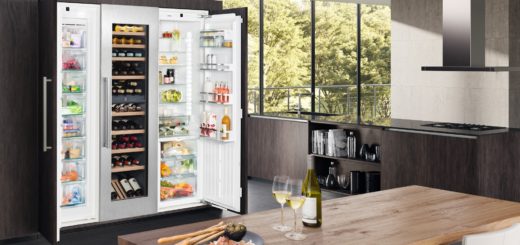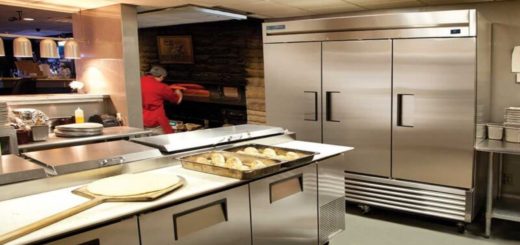Most Common Refrigerator Problems and Repairs
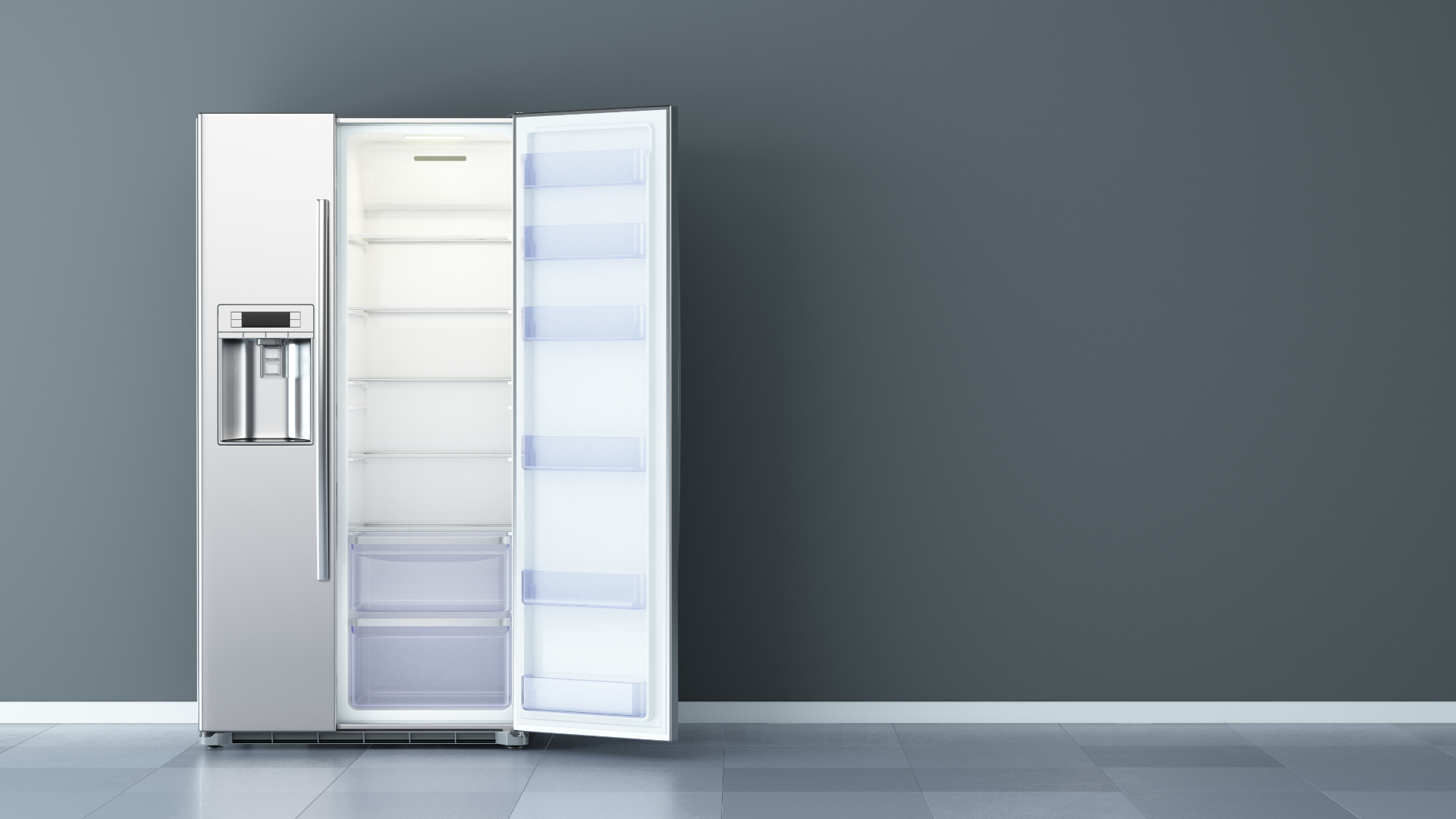
Biggest Complaints with fridges:
-
No water / ice coming out of dispenser
- If your ice maker has a rake, ice could get caught in it. The ice rake helps to distribute the ice evenly in the bin so it does not to become uneven.
- The fix to this is usually going in by hand and removing the ice that is blocking the rake arm. At times, it may become stuck because the ice maker has too much ice inside it. If this is the case, you will want to remove the excess ice cubes.
- Sometimes the problem could be the Auger motor being frozen. This may cause a few ice cubes to come but won’t produce new ice cubes down the chute. When this is the situation, you will want to keep the lever depressed. As the auger motor runs. It will cause the auger motor to start to warm up and melt the ice on it. This is a quick fix, but it is one that is hard on the Auger motor. You may want to look into how moisture got behind the freezer walls to freeze the motor in the first place. Important to note that melting moisture could damage the motor.
- If one of the dispenser switches is defective, the water/ ice dispenser will not work. To determine if a dispenser switch is defective, use a multimeter and test each switch for continuity. If a dispenser switch does not have continuity, replace it at Guaranteed Parts.
-
Icemaker doesn’t make ice
- If your ice maker isn’t producing ice or is producing cubes that are smaller than usual, it’s typically indicative of a clog somewhere along the water line. A common cause for a clog is frozen water in the line. To repair a frozen line, slide the refrigerator and unplug for upward of two hours.
- If there is ice inside the bin but not coming out of the dispenser it’s most likely a mechanical or electrical problem. Commonly the control arm may be nudged into the off position, which halts production of ice. Locate the metal control arm and move it to the down or on position and this should fix it. If this does not fix the problem the motor, gearbox or electrical connection might be faulty.
-
Ice buildup in the fridge
- Ice buildup occurs when warm or humid air comes in contact with the cold evaporator coils in your freezer. The coils will instantly freeze the moisture and, if there’s enough of it, it will accumulate as ice inside your fridge. This sometimes happens when the fridge door is not shut properly and it lets warm air inside the refrigerator. Sometimes tweaking the legs to tilt the top of the fridge backwards helps with encouraging the door to shut with gravity. Ensure the hinges on the door are tight otherwise there will be an incomplete seal. Gaskets sometimes have food residue or ice crystal and the door may not close properly. Keep the gasket clean and make sure it is not damaged. To replace a damaged door gasket call Guaranteed Parts at 1-855-472-4443
-
Water leaking
- Water leakage typically is caused from a blocked defrost drain. This happens when food/ debris clog up the drain hose. This can lead to ice buildup and, eventually, water leaking out of the freezer and fridge.
- Interior water leak—interior defroster drain line problem.
- Rear water leak—problem with the ice maker or water line.
- Front water leak—clogged drain tube.
- Bottom centre leak—drain pan
-
Fridge not cooling
- Clogged coils can cause poor refrigeration cooling. Check to make sure nothing is stuck in the condenser fan and that it spins freely. Models with coils on the back won’t have a fan on their unit. Sometimes the thermostat is too low which will cause the fridge to not be at the correct temperature to keep your food cool. Ensure the interior vents are not blocked by items, therefore keeping air from circulating in the fridge.
- Most refrigerators contain two fans that are a large part of the unit’s operation, and if they are not working, that can be a reason your fridge is not cold enough. The condenser fan cools items like the condenser coils and the compressor while they are operating.
- The condenser fan needs to operate to keep the fridge from overheating and ceasing to operate.
- The evaporator fan moves the air in your refrigerator. This fan pulls air across your evaporator coil, cooling the air down and then it moves air through the refrigerator. If this fan is not working, cold air will not get into your refrigerator.
- Another issue that may be causing problems is a faulty air damper. This item regulates the airflow between the freezer and the refrigerator. Your freezer may work adequately if it is not working correctly, but there may not be enough cold air getting into your fridge.
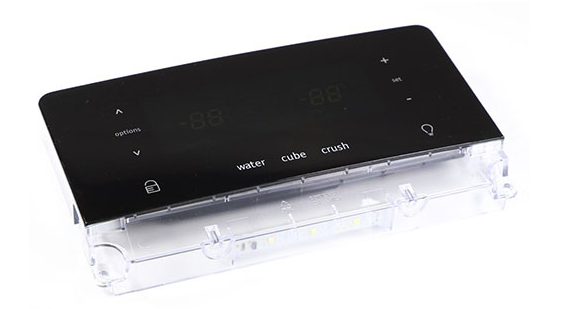
-
Control panel / circuit board faulty
- The dispenser control board runs most of the functions of the dispenser system. If just one dispenser part is not working, it is likely that an individual part has failed. In this case, test all of the dispenser components before testing the control board. If the entire dispenser system is not working, the control board is more likely to be at fault.
- The main control board might be defective. Though, the control board is rarely at fault for this problem. Before replacing the control board, first check all of the dispenser components. If none of the dispenser components are defective, consider replacing the main control board.
-
Food not keeping cold
- Unplug the fridge and vacuum the coils behind and under the fridge. Clogged coils can cause poor cooling. Check to make sure nothing is stuck in the condenser fan and that it spins freely (models with coils on the back won’t have a fan). Make sure the fan runs when the compressor is running.
- A faulty air damper can stop cold air from moving freely throughout your refrigerator. Inspect the air damper and if it does not close or open, it may be time to replace this part at Guaranteed Parts.
-
Broken drain / outlet
- If your fridge is leaking water, freezer has frost build-up or is not defrosting you may need to replace or clear the refrigerator drain pipe.
- This drain hole is in place to catch the water which collects in a fridge, particularly that which builds up on the back wall of the fridge. If the drain hole becomes blocked or broken this causes problems for the rest of your fridge.
- Water produced during the defrost cycle in your refrigerator model travels through the drain pipe and into the drain pan. Ice build up on the floor of your freezer, or water leaking from your refrigerator indicates the drain pipe is either damaged or clogged. Replacing the defective drain pipe is the best way to eliminate the leakage and ice problem.
-
Broken / faulty compressor
-
- A symptom of a bad refrigerator compressor is when the refrigerator stops cooling. This would mean some areas of the fridge are not as cool as needed.
- The compressor is faulty when it starts making unusual noises; the compressor overheats, when the fridge compressor clicks on and off too frequently or not providing proper cooling.
- There are many reasons why the compressor would fail:
- Dirty condenser coils (The compressor has to work harder which causes overheating)
- Refrigerant problems (too much or too little refrigerant and the refrigerant being contaminated can cause the compressor to malfunction. This is a job of a qualified technician to check.)
- High voltage surge (lightning strikes usually cause excessive amount of heat)
- General wear and tear after years of use
- A faulty compressor relay may also be the cause of the fridge compressor not functioning correctly. The compressor start relay is the component that supplies power to the compressor. The simplest way to diagnose a faulty relay for failure (First unplug fridge) is to remove and shake the relay close to your ear. If you hear a rattling noise, it means the compressor relay should be replaced.
- With a faulty compressor, there’s not much you can do but replace it or replace the entire refrigerator with a newer model.
If you have questions about refrigerator parts please contact Guaranteed Parts online or by calling: 1-855-472-4443

